| کد مقاله | کد نشریه | سال انتشار | مقاله انگلیسی | نسخه تمام متن |
|---|---|---|---|---|
| 2451048 | 1109670 | 2009 | 10 صفحه PDF | دانلود رایگان |

This study investigated how accurately taste panel sensory assessments of meat eating quality (MEQ) could be predicted in two divergent lamb breeds, using predictors measured in live animals (weights, subjective conformation assessments, ultrasound, computed tomography (CT) and video image analysis measurements) and carcasses (weights, MLC fat and conformation classes, pH, temperature, carcass dimensions and cross-sectional tissue dimensions), individually and in optimal combinations. Grilled muscle samples from the pelvic limb (semimembranosus) and loin (Longissimus lumborum) of 120 Texel (TEX) and 112 Scottish Blackface (SBF) lambs were assessed by a trained taste panel for texture, juiciness, flavour, abnormal flavour and overall liking. Residual correlations (adjusted for fixed effects, age and sire) between MEQ and predictor traits were low to moderate in size (<±0.42). MEQ traits predicted best by single measurements were loin flavour and overall liking for TEX (using fat area in a CT scan or subcutaneous fat depth measured post-mortem), and for SBF were leg texture (using carcass weight or temperature) and juiciness (using CT fat area or shoulder conformation score). Combining live animal and carcass measurements increased MEQ prediction accuracies, compared with using either set alone, to explain >40% of residual variation in several MEQ traits, with the highest adjusted R2 values for leg juiciness in TEX (0.53) and leg texture in SBF (0.59). The most useful predictors of MEQ depended on breed, with measurements of fatness generally more important in the lean breed and carcass size and muscling more important in the fatter breed.
Journal: Meat Science - Volume 83, Issue 3, November 2009, Pages 366–375